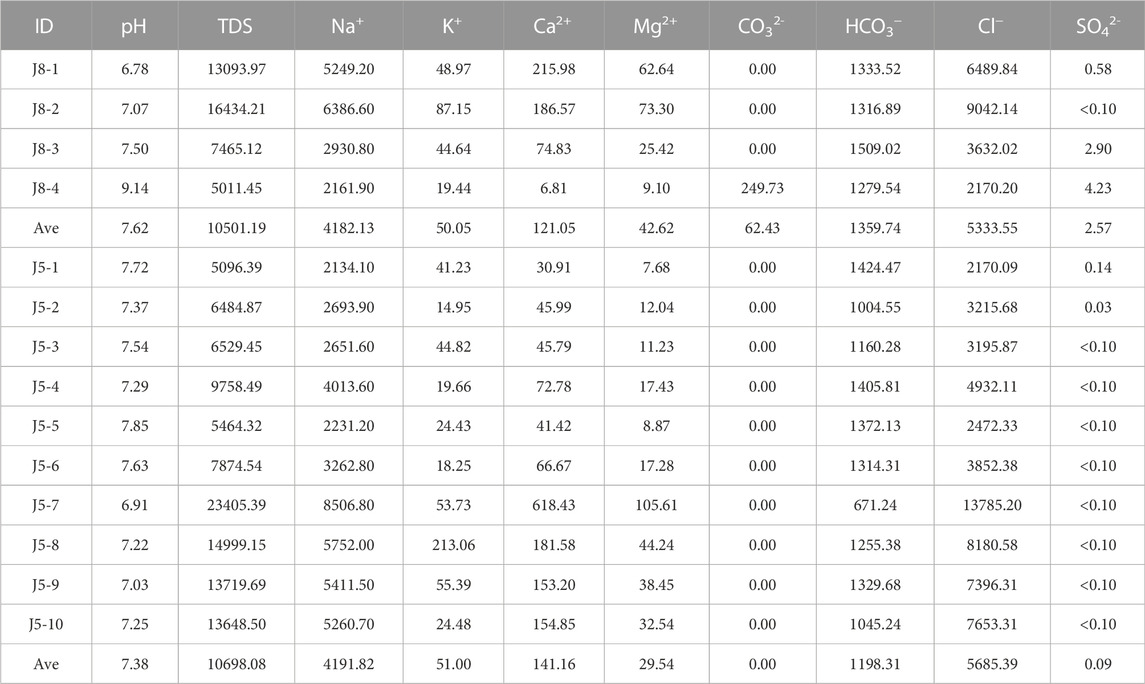- 1Petroleum Engineering School, Southwest Petroleum University, Chengdu, China
- 2Institute of Engineering and Technology, PetroChina Coalbed Methane Company Limited, Xi’an, China
- 3College of Geology and Environment, Xi’an University of Science and Technology, Xi’an, China
- 4College of Chemistry and Chemical Engineering, Xi’an University of Science and Technology, Xi’an, China
Linfen mining area is one of the main coalbed methane industrial bases in the eastern margin of Ordos Basin, China. However, there are few studies on the hydrogeochemical characteristics of coalbed-produced water in the area. This article collected water samples from 14 coalbed methane drainage wells and analyzed the ionic concentrations, hydrogen and oxygen isotopes, dissolved inorganic carbon isotopes (δ13CDIC) and trace elements. The results showed that the water of Nos. Five and eight coal seams are both Cl-Na type. The total dissolved solids content was high, ranging from 5011.45 mg/L to 23405.39 mg/L. Hydrogen and oxygen isotope data indicated that the coalbed-produced water in the study area is recharged from atmospheric precipitation. In addition, the HCO3− in the produced water of No. Five coal seam and No. Eight coal seam was negatively correlated with δ13CDIC. The value δ13CDIC in the produced water of No. Five coal seam was heavier than that of No. Eight coal seam. These indicate that microbial degradation occurred more strongly in No. Five coal seam than in No. Eight coal seam. The water-rock interaction in the study area was found to be dominated by cation exchange and dissolution filtration through the relationships between anion and cation.
1 Introduction
Coalbed methane (CBM) is mixture gases dominated by methane that is mainly adsorbed on the surface of coal matrix and partially free in the pores and fissures of coal, and has shown good development potential in recent years as an efficient and clean energy source (Zhang and Qin, 2018; Bao et al., 2020). China is rich in CBM resources. At present, two CBM development bases in the Qinshui Basin and the eastern edge of the Ordos Basin have been established and commercialized (Qin et al., 2012; Huang H. X. et al., 2018). Mining CBM not only relieves the pressure of conventional natural gas supply, but also greatly reduces the probability of accidents in coal mines through pre-pumping. While ensuring safety and improving economic efficiency, it is also conducive to environmental protection and provides a strong guarantee for clean energy. The principle of CBM drainage is to pump the groundwater into the coal seam and its surrounding rocks (Liu et al., 2013), reduce the pressure in the coal reservoir, desorb the gas adsorbed in the coal reservoir and diffuse, percolate and transport it into the wellbore through the pores and fractures, so that it can be exploited (Tao et al., 2011). The coalbed-produced water experienced a long-time contact with the coal seam and surrounding rocks underground, which contained rich geochemical information (Bao et al., 2021). As a direct product of CBM well drainage, coalbed-produced water has an important impact on CBM enrichment mechanism and exploration and development research (Bao et al., 2021).
In recent years, research on coalbed-produced water has received increasing attention from scholars at domestic and international (Bao et al., 2016; Guo et al., 2017; Guo et al., 2020). Previous studies have also done a lot of research around the geochemical characteristics of the coalbed-produced water (Bao et al., 2016; Guo et al., 2017; Zhang et al., 2018; Guo et al., 2020). Since Craig (1961) first proposed the global precipitation line (GMWL), hydrogen and oxygen isotopes have been widely used in hydrogeochemical studies (Zheng et al., 1983; Chen et al., 2011; Bao et al., 2021). Hydrogen and oxygen isotopes have played an important role in determining the source of water and the types and mechanisms of water-rock interactions (Bozau et al., 2017; Hao et al., 2019). Water-rock interaction refers to the physicochemical reaction between groundwater and surrounding rock during the geological action of coalbed-produced water, which generally includes cation exchange, rock dissolution and filtration, and evaporation and concentration (Li Q. G. et al., 2016; Li X. et al., 2016; Huang X. J. et al., 2018). Bao et al. (2021) investigated the hydrogeochemical characteristics of coalbed-produced water from the Dafosi biogas field on the southern margin of Ordos and found that cation exchange occurs in coalbed-produced water in this area. Qin et al. (2014) proposed a method to distinguish between the source resolution of the produced water and the mixed CBM feasibility discrimination based on the trace element concentration in the coalbed-produced water. Redwan et al. (2016) investigated the effect of water-rock interaction on the chemical elements of coal-bearing rocks and applied statistical methods to identify and evaluate water-rock reaction processes. Therefore, the geochemical index of coalbed-produced water is a good indicator of the water source and water-rock interaction process.
The Linfen mining area is located at the eastern margin of the Ordos Basin and is rich in CBM resources (Huang H. X. et al., 2018). Although the CBM in this area has undergone more than two decades of exploration and development, little research has been conducted on the mechanism of water-rock interaction in the coalbed-produced water in this area. The geochemical characteristics of the coalbed-produced water can predict the CBM enrichment area, which is important for drainage. Therefore, this article collected water samples from 14 CBM wells with single-layer discharge in the study area, and tested their pH, total dissolved solids (TDS), conventional ions, hydrogen and oxygen isotopes, dissolved inorganic carbon isotopes and trace elements to analyze the water chemistry types, ionic composition characteristics and sources of coalbed-produced water. The water-rock action types and mechanisms were also elucidated. The research results can provide theoretical support for the exploration and development of CBM in the study area and the selection of the sweet spot area.
2 Sample collection and test methods
2.1 Sample collection
There are 220 CBM extraction wells in Linfen mining area. The main CBM wells are developed in the No. Five coal seam of Shanxi Formation and No. Eight coal seam of Taiyuan Formation. The well types are straight wells and directional wells. According to the location of CBM wells and single layer drainage, a total of 14 representative coalbed-produced water samples were collected to cover the whole area as much as possible, including 10 samples from No. Five coal seam and four samples from No. Eight coal seam. Sample numbers were J5-1, J5-2, J5-3, J5-4, J5-5, J5-6, J5-7, J5-8, J5-9, J5-10, J8-1, J8-2, J8-3, J8-4, respectively. Before sample collection, polyethylene sampling bottles were sterilized in the laboratory under UV light. The water samples were collected using 2.5 L and 500 ml polyethylene sampling bottles at the drainage of CBM wells to collect coalbed-produced water. The 500 ml polyethylene sampling bottles were acidified to pH <3 with dilute hydrochloric acid on site for subsequent cation detection. The 2.5 L polyethylene sampling bottles were used to collect raw water samples for pH, anion, TDS, trace elements, hydroxide isotopes and dissolved inorganic carbon isotope composition. The water samples were collected in the field by rinsing the polyethylene sampling bottle three times with the coalbed-produced water. Then filtered microorganisms, coal dust and suspended substances with 0.5 μm filter paper placed at the mouth of the bottle, and filled the bottle to remove the air from the bottle. Next sealed the bottle with the cap and checked whether it leaked. Finally marked the sampling time and place and sent it to the Guizhou Institute of Geochemistry, Chinese Academy of Sciences for testing.
2.2 Test methods
The water samples were tested for anions and cations, hydrogen and oxygen isotopes of water, dissolved inorganic carbon isotopes and trace elements. Among them, the instrument used for cation test is Vista MPX inductively coupled plasma - emission spectrometer of Varian, United States. The anion test used ion chromatography (Thermo Fisher ICS-90). The HCO3− and CO32− ion test used acid titration method to detect. Anion and cation detection standards referred to GB/T 5750.6-2006 and DZ/T 0064.51-1993, respectively. The instrument used for hydrogen and oxygen isotope testing was the liquid isotope analyzer 912-0026, with a standard deviation of 0.6‰ for δD and 0.1‰ for δ18O. The isotopes of dissolved inorganic carbon were measured by gas isotope mass spectrometer MAT252 with an accuracy of ≤0.01‰. The isotopes of hydrogen, oxygen and inorganic carbon were measured according to DZ/T 0184.19-1997, DZ/T 0184.21-1997 and GB 13193-91, respectively.
The pH was measured by PP-50-p11 m and TDS was measured by DDSJ-308A conductivity meter. The testing standards were executed according to GB/T 6920-1986 and DZ/T 0064.9-1993, respectively.
3 Results and analysis
3.1 Produced water conventional ion
The results of water quality testing and analysis of coalbed-produced water in the Linfen mining area were shown in Table 1. The pH of the produced water of No. Five coal seam ranged from 6.91 to 7.85 with an average value of 7.38. The produced water of No. Five coal seam was weakly alkaline, which was favorable to the survival of methanogenic bacteria in the coalbed-produced water. The pH of the produced water of No. Eight coal seam ranged from 6.78 to 9.14 with an average value of 7.62. But the pH of No. Eight coal seam had a larger span and a higher average pH than that of No. Five coal seam. The cations of coalbed-produced water in the study area are mainly Na+. The concentration of Na+ ranges from 2134.10 to 8506.80 mg/L. In addition, they also contain certain concentrations of Ca2+, Mg2+ and K+. The anions were dominated by Cl−. The concentration of Cl− ranges from 2170.09 to 13,785.20 mg/L. In addition, they also contained CO32−, HCO3− and SO42−. Among them, CO32− was only detected in J8-4 with a concentration of 249.73 mg/L. The concentration of HCO3− ranges from 671.24 to 1509.02 mg/L, and higher levels of HCO3− were detected in 10 CBM wells in No. Five coal seam and four CBM wells in No. Eight coal seam. The higher content of HCO3− suggested a higher degree of confinement in the groundwater environment. The SO42− concentration ranges from <0.10 to 4.23 mg/L. The concentration of TDS in the study area ranges from 5011.45 mg/L to 23,405.39 mg/L. The TDS of J5-7, J5-8, J5-9, J5-10, J8-1 and J8-2 were all higher than 13,000 mg/L. The higher mineralization may be related to groundwater rock action.
The data of 14 sets of water samples from the Linfen mining area were plotted on a Piper trilinear graph (Figure 1A), showing that the water chemistry type in the study area is Cl-Na type. According to the box plot of ion concentrations in coalbed-produced water in the study area (Figure 1B), the concentrations of Na+, Cl− and HCO3− are much larger than other ions. The data are more concentrated, with the median line located almost half of the length of the square box, indicating that the concentrations of Na+, Cl− and HCO3− ions do not vary much. The concentration of SO42− is lower and the data are scattered. The lower quantile line of Ca2+ and SO42− box plots with the lower quantile line far from the square box imply that the Ca2+ and SO42- concentration content of each individual well is low and varies more than most CBM wells. The anomalous data were marked by boxes in the graph. The presence of anomalous values of K+, Ca2+, Mg2+, and HCO3− concentrations in the coalbed-produced water indicate that they are related to the groundwater environment and that groundwater-rock interactions need to be identified.
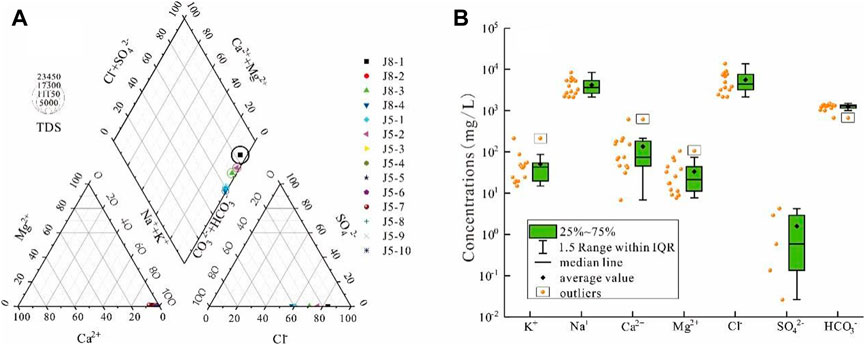
FIGURE 1. Piper diagram [(A); Bao et al., 2021 and box chart of ion concentrations (B); Guo et al., 2017] of coalbed-produced waters in the Linfen mining area.
3.2 Hydrogen, oxygen, and carbon isotopic signatures
Table 2 shows the hydrogen, oxygen and carbon isotope values of the coalbed-produced water in the Linfen mining area. As shown in, the hydrogen and oxygen isotopes of the produced water from No. Five coal seam and No. Eight coal seam do not differ significantly. δD ranges from −85.84‰ to −64.31‰, with an average value of −75.22‰. δ18O ranges from −12.14‰ to −9.07‰, with an average value of −10.74‰. However, the inorganic carbon isotopes of the produced water from No. Five coal seam and No. Eight coal seam differed significantly. The dissolved inorganic carbon isotopes δ13CDIC of the produced water from No. Eight coal seam ranges from 7.98‰ to 12.68‰ with a mean value of 10.36‰. The dissolved inorganic carbon isotopes δ13CDIC of the produced water from No. Five coal seam ranges from 25.79‰ to 36.50‰ with a mean value of 30.59‰. All of the δ13CDIC in the study area exhibited positive values, indicating that dissolved CO2 in groundwater is enriched in 13C (Li et al., 2022).
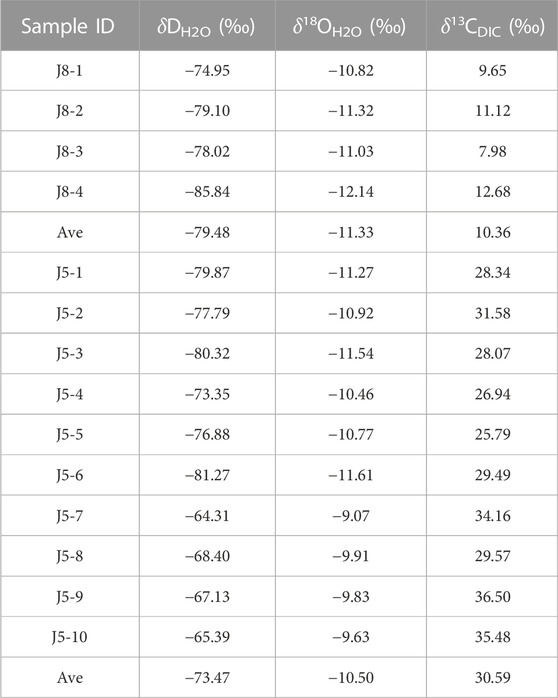
TABLE 2. Hydrogen and oxygen isotopic and DIC carbon isotopic compositions of coalbed-produced water in the Linfen mining area.
3.3 Produced water trace elements
In this article, a total of 22 trace elements were detected in the coalbed-produced water of the Linfen mining area. The average content of Cd, Cu, Hg, Pb, Sb, Sn, Ti, Tl, U, and Zr elements below 0.10 μg/L were not analyzed, and the statistical results of other elements with stable distribution and high content were shown in Table 3. The trace elements in the produced water of No. Five coal seam and No. Eight coal seam do not vary much. The content of Li in this area ranges from 287.88 to 1923.32 μg/L, with an average value of 721.11 μg/L. The content of Al ranges from 1.60 to 61.57 μg/L, with an average value of 14.77 μg/L. The content of As ranges from 1.25 to 9.48 μg/L, with an average value of 4.24 μg/L. The content of Ba ranges from 4323.18 to 69,528.23 μg/L, with an average value of 35,064.76 μg/L. The content of Co ranges from 0.10 to 5.02 μg/L, with an average value of 1.31 μg/L. The contents of Ni ranges from 0.52 to 39.43 μg/L, with an average value of 15.28 μg/L; The contents of Cr ranges from 0.65 to 1.13 μg/L, with an average value of 0.85 μg/L; The contents of Zn ranges from 0.75 to 16.89 μg/L, with an average value of 7.23 μg/L; The contents of Sr ranges from 3996.26 to 107,240.41 μg/L, with an average value of 28,282.97 μg/L; The contents of Rb ranges from 13.25 to 79.23 μg/L, with an average value of 37.30 μg/L. The content of Mo ranged from 1.52 to 143.37 μg/L, with an average value of 20.00 μg/L. The content of Mn ranges from 21.47 to 1116.92 μg/L, with an average value of 434.81 μg/L. The concentrations of Li, Ba, Sr, Rb, Mo and Mn in the coalbed-produced water are relatively high, and the average values are all greater than 20 μg/L. Ba is the trace element with the highest content in the coalbed-produced water in this area. The average concentrations of trace elements in the coalbed-produced water in this area are Ba>Sr>Li>Mn>Rb>Mo>Zn>As>Co>Cr.
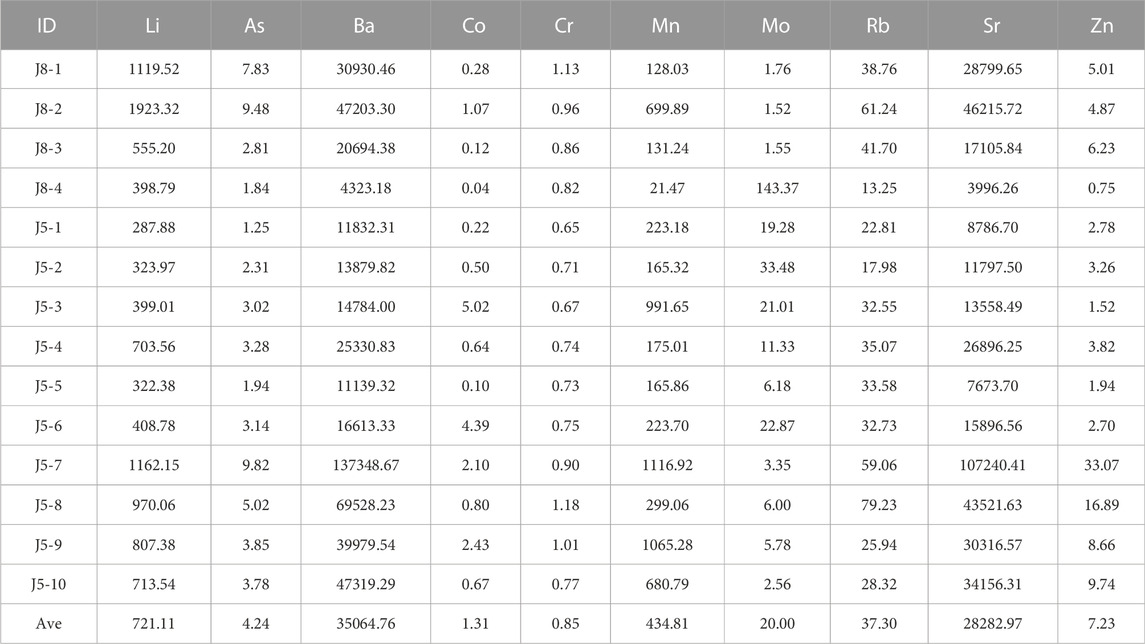
TABLE 3. Results of trace element concentration of coalbed-produced water in the Linfen mining area (unit, μg/L).
4 Discussions
4.1 Source of coalbed-produced water
The hydrogen-oxygen isotopic composition of coalbed-produced water can reflect the source of produced water. Craig (1961) obtained the global meteoric water line (GMWL) as: δD = 8δ18O+10. The Chinese meteoric water line (CMWL) first proposed by Zheng et al. (1983), expressed as: δD = 7.9δ18O+8.2. The hydrogen-oxygen isotope data in Table 2 were projected onto the δ18O-δD relationship diagram (Figure 2), it was found that the hydrogen-oxygen isotope projections of the produced water from 14 CBM wells in the study area were all located near the GMWL and CMWL. It showed that the coalbed-produced water in the study area originated from atmospheric precipitation and received recharge from atmospheric precipitation, providing a way to carry microorganisms into the coal seam for microbial degradation to occur.
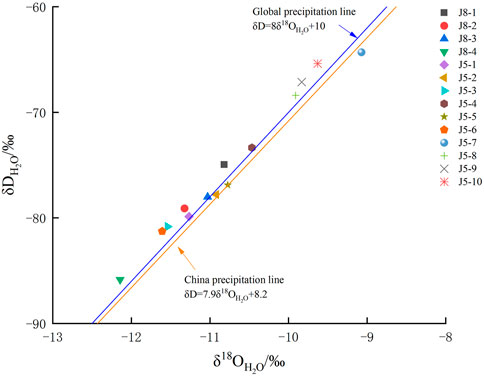
FIGURE 2. Relationship between δD(H2O) and δ18O(H2O) of coalbed-produced water in the Linfen mining area (modified from Bao et al., 2021).
4.2 Microbial action
Dissolved inorganic carbon in coalbed-produced water is generally considered to originate from dissolution of carbonate minerals, dissolution of CO2 in CBM, and microbial action (Lemay and Konhauser, 2006). Figure 3 showed the relationship between HCO3− and δ13CDIC in the coalbed-produced water in the study area. As shown in, both were positive and showed a significant negative correlation. This suggested that strong microbial action had occurred in situ in the coal seam in the study area. The positive δ13C values indicate the occurrence of methanogenesis in groundwater environments because methanogens preferentially utilize 12CH4, resulting in the remaining 13C enriched in CO2 and DIC (Meng et al., 2014; Li et al., 2022). The comparison shows that No. Five coal seam δ13CDIC is heavier than that of No. Eight coal seam, implying that microbial degradation occurs more strongly in No. Five coal seam than in No. Eight coal seam.

FIGURE 3. Relationship between δ13CDIC and HCO3− of coalbed-produced water in the Linfen mining area.
4.3 Water-rock interaction and mechanism
Figure 4 shows the radar map of trace element content distribution in coalbed-produced water. The content of Ba, Sr, Mn, Li and other elements are relatively high. On the one hand, these trace elements have their own active chemical properties and easily loss or gain electrons with existing in ion form in produced water. On the other hand, Ba, Sr, and Mn elements have high affinity for silica-aluminates. Li element has carbonate affinity (Dai et al., 2005), and these properties result in different trace elements. During the contact between the coal seam and the surrounding rocks, a certain degree of enrichment of these trace elements will occur in the water through dissolution-precipitation, adsorption of substances such as iron-manganese oxides and hydroxides, carryover of organic matter and ion exchange of clay minerals, etc. In addition, the stronger the groundwater dynamic conditions, the stronger the water-rock interaction will be, and the higher the element dissolution will be. As a result, the coalbed-produced water contains higher concentrations of trace elements such as Ba, Sr, Mn and Li.
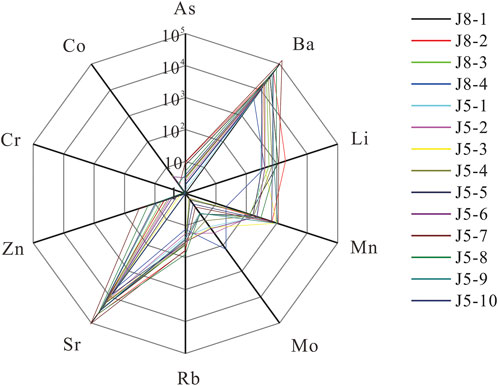
FIGURE 4. Radar map of trace elements concentration of coalbed-produced water in the Linfen mining area.
The source of ions and the process of water-rock action can be determined from the relationship between the content of major ions in water (Lakshmanan et al., 2003). The occurrence of cation exchange is usually reflected by the ratio relationship between γ(Na+-Cl−) and γ[(Ca2++Mg2+)-(HCO3−+SO42−)] (Tang et al., 2013). The relationship between the chloride base index (CAI-Ⅰ=[Cl−-(Na++K+)/Cl−]) and (CAI-Ⅱ=[Cl−-(Na++K+)]/(SO42−+HCO3−+CO32−)) relationships can characterize the direction and intensity of ion exchange (Li et al., 2013). The ratio relationship between γ(Na++K+) and γ(Cl−) can reflect the source of Na+ and K+ (Li et al., 2015). The relationship between the ratio of γ(Ca2++Mg2+) and γ(HCO3−+SO42−) can determine the source of Ca2+ and Mg2+ in the produced water (Tang et al., 2013). The relationship between the ratio of γ(Ca2++Mg2+-HCO3−) and γ[SO42--(Na+-Cl−)] can reflect the source of SO42− in the produced water (Singh et al., 2015).
The relationship between γ(Na+-Cl−) and γ[(Ca2++Mg2+)-(HCO3−+SO42−)] of the coalbed-produced water in the study area is shown in (Figure 5A), which show a significant negative correlation (R2=0.77), indicating that cation exchange is occurring in this mine. The chloride and alkali index of the coalbed-produced in the Linfen mining area is almost less than 0 (Figure 5B), implying that positive cation exchange occurs mainly in the study area. Exchange Ca2+ and Mg2+ in the water with Na+ in the surrounding rocks, resulting in an increase in the Na+ content in the coalbed-produced water. The reaction mechanism is shown in Eq. 1 (Houatmia et al., 2016).
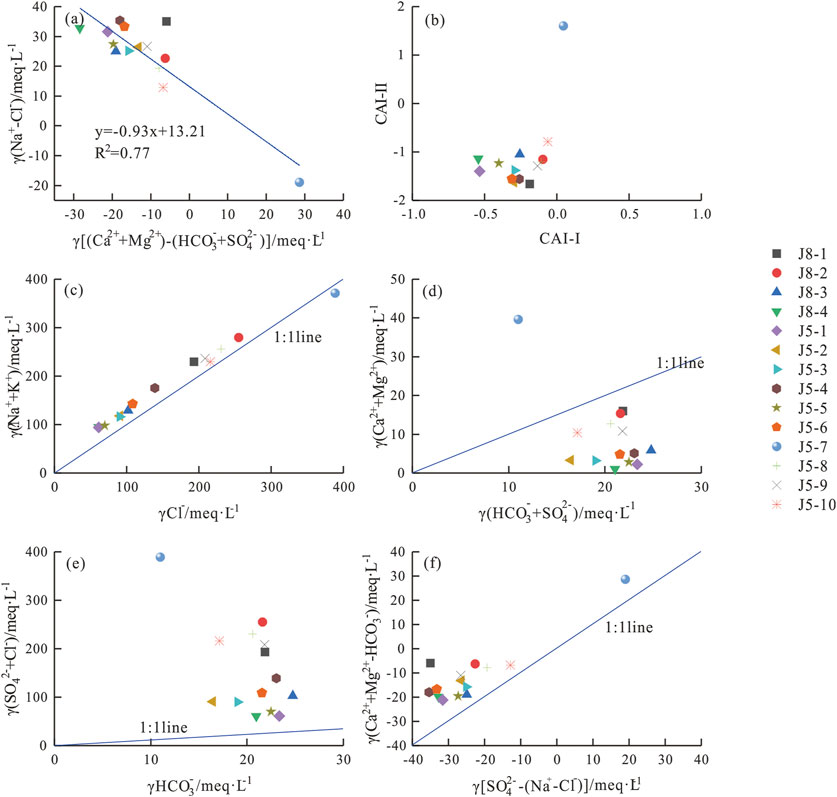
FIGURE 5. Relationship between hydrochemical compositions: (A) molar ratio of [(Ca2++Mg2+)-(HCO3−+SO42-)] vs. (Na+-Cl-); (B) chloro-alkaline indices (CAI); (C) molar ratio of (Cl−) vs. (Na++K+); (D) molar ratio of (HCO3−+SO42-) vs. (Ca2++Mg2+); (E) molar ratio of (HCO3−) vs. (SO42-+Cl−); (F) molar ratio of [SO42--(Na+-Cl−)] vs. (Ca2++Mg2+-HCO3-). The ionic unit is meq/L (modified from Bao et al., 2021).
The sample points of the coalbed-produced water in the study area basically fall above the γ(Na++K+)/γ(Cl−)=1:1 line (Figure 5C), indicating that the main source of Na+ and K+ in the study area is the dissolution of silicate minerals such as potassium feldspar and sodium feldspar. The reaction mechanism is shown in Eqs 2, 3.
The ratio of γ(Ca2++Mg2+) to γ(HCO3−+SO42−) in the coalbed-produced water in Linfen mining area is almost all less than 1 (Figure 5D), suggesting that the dissolution of silicate minerals and evaporite is the main source of Ca2+ and Mg2+ in the coalbed-produced water (Li et al., 2015). Figure 5E shows the scatter plot of γ(SO42−+Cl−) to γ(HCO3−) milligram equivalent ratio of coalbed-produced water, which can reflect the dissolved evaporite and carbonate rocks in the water column (Tang et al., 2013). The sample points of the coal seam produced water in the study area were mainly distributed above the 1:1 line, exhibiting that the dissolution of evaporite in the produced water mainly occurred in the study area. γ(Ca2++Mg2+-HCO3−) can characterize the Ca2+ concentration and γ[SO42−-(Na+-Cl−)] can characterize the SO42− concentration of gypsum dissolution in the produced water. The sample points of coal seam output water in the study area were all distributed above the γ(Ca2++Mg2+-HCO3−)/γ[SO42−-(Na+-Cl−)] = 1:1 line (Figure 5F), displaying that SO42− in coalbed-produced water mainly originated from the dissolution of gypsum and mannite.
5 Conclusion
The water chemistry of the produced water from No. Five coal seam and No. Eight coal seam in the study area is of Cl-Na type and the TDS concentration is generally high. The degree of confinement of the groundwater environment is high, which is favorable to the generation of biogas. The hydrogen-oxygen isotope relationship indicates that the coalbed-produced water in Linfen mining area originates from atmospheric precipitation, which provides a way to carry microorganisms into the coal seam for microbial degradation. The pH value of the No. Five coalbed-produced water in the Shanxi Formation of the Linfen mining area is weakly alkaline and lower than that of the No. Eight coalbed-produced water, implying that the in situ water in the No. Five coal seam is favorable for the survival of methanogenic bacteria. Meanwhile, the δ13CDIC value of the produced water from No. Five coal seam is significantly heavier than that of No. Eight coal seam, indicating that microbial degradation occurs more strongly in No. Five coal seam than in No. Eight coal seam.
Water-rock interaction in the study area is dominated by cation exchange and dissolution filtration, resulting in relatively high contents of trace elements such as Li, Ba, Sr and Mn in the coalbed-produced water. The Na+ in the coalbed-produced water mainly comes from the dissolution of sodium feldspar minerals and the cation exchange of Ca2+ and Mg2+ in the water with Na+ in the surrounding rocks. The K+ mainly comes from the dissolution of potassium feldspar silicate minerals. The Ca2+ and Mg2+ mainly come from the dissolution of silicate minerals and evaporite. The SO42− and Cl− mainly come from the dissolution of evaporite (gypsum, mannite, etc.).
Data availability statement
The original contributions presented in the study are included in the article/Supplementary Material, further inquiries can be directed to the corresponding author.
Author contributions
All authors listed have made a substantial, direct, and intellectual contribution to the work and approved it for publication.
Funding
This work was supported by the National Natural Science Foundation of China (grant numbers: 42172200; 41972183).
Conflict of interest
Authors YW and YY are employed by PetroChina Coalbed Methane Company Limited, China.
The remaining authors declare that the research was conducted in the absence of any commercial or financial relationships that could be construed as a potential conflict of interest.
Publisher’s note
All claims expressed in this article are solely those of the authors and do not necessarily represent those of their affiliated organizations, or those of the publisher, the editors and the reviewers. Any product that may be evaluated in this article, or claim that may be made by its manufacturer, is not guaranteed or endorsed by the publisher.
References
Bao, Y., An, C., Wang, C. Y., Guo, C., and Wang, W. B. (2021). Hydrogeochemical characteristics and water–rock interactions of coalbed-produced water derived from the Dafosi biogenic gas field in the southern margin of Ordos Basin, China. Geofluids 2021, 1–13. doi:10.1155/2021/5972497
Bao, Y., Ju, Y. W., Yin, Z. S., Xiong, J. L., Wang, G. C., and Qi, Y. (2020). Influence of reservoir properties on the methane adsorption capacity and fractal features of coal and shale in the upper Permian coal measures of the south Sichuan coalfield, China. Energy Explor. Exploitation 38 (1), 57–78. doi:10.1177/0144598719877527
Bao, Y., Wei, C. T., and Neupane, B. (2016). Generation and accumulation characteristics of mixed coalbed methane controlled by tectonic evolution in Liulin CBM field, eastern Ordos Basin, China. J. Nat. Gas Sci. Eng. 28, 262–270. doi:10.1016/j.jngse.2015.11.033
Bozau, E., Licha, T., and Ließmann, W. (2017). Hydrogeochemical characteristics of mine water in the Harz Mountains, Germany. Geochemistry 77 (4), 614–624. doi:10.1016/j.chemer.2017.10.001
Chen, L. W., Gui, H. R., and Yin, X. X. (2011). Monitoring of flow field based on stable isotope geochemical characteristics in deep groundwater. Environ. Monit. Assess. 179, 487–498. doi:10.1007/s10661-010-1751-6
Craig, H. (1961). Isotopic variations in meteoric waters. Science 133 (3465), 1702–1703. doi:10.1126/science.133.3465.1702
Dai, J. X., Li, J., Luo, X., Zhang, W., Hu, G., Ma, C., et al. (2005). Stable carbon isotope compositions and source rock geochemistry of the giant gas accumulations in the Ordos Basin, China. Org. Geochem. 36 (12), 1617–1635. doi:10.1016/j.orggeochem.2005.08.017
Guo, C., Qin, Y., Wu, C. F., and Lu, L. L. (2020). Hydrogeological control and productivity modes of coalbed methane commingled production in multi-seam areas: A case study of the bide–santang basin, Western Guizhou, south China. J. Petroleum Sci. Eng. 189, 107039. doi:10.1016/j.petrol.2020.107039
Guo, C., Qin, Y., Xia, Y. C., Ma, D., Han, D., Chen, Y., et al. (2017). Geochemical characteristics of water produced from CBM wells and implications for commingling CBM production: A case study of the bide-santang basin, Western Guizhou, China. J. Petroleum Sci. Eng. 159, 666–678. doi:10.1016/j.petrol.2017.09.068
Hao, C. M., Huang, Y., He, P. Y., and Sun, W. (2019). Isotope drift characteristics in ordovician limestone karst water caused by coal mining in northern China. Mine Water Environ. 38 (3), 507–516. doi:10.1007/s10230-019-00606-4
Houatmia, F., Azouzi, R., Charef, A., and Bedir, M. (2016). Assessment of groundwater quality for irrigation and drinking purposes and identification of hydrogeochemical mechanisms evolution in Northeastern, Tunisia. Environ. Earth Sci. 75 (9), 746. doi:10.1007/s12665-016-5441-8
Huang, H. X., Nie, Z. H., Chao, H. Y., Chen, D., and Liu, Y. (2018). Discussion of the selection for producing layers of deep CBM wells in Linfen block. J. China Coal Soc. 43 (6), 1627–1633. doi:10.13225/j.cnki.jccs.2018.4041
Huang, X. J., Wang, G. C., Liang, X. Y., Cui, L. F., Ma, L., and Xu, Q. Y. (2018). Hydrochemical and stable isotope (δD and δ18O) characteristics of groundwater and hydrogeochemical processes in the ningtiaota coalfield, northwest China. Mine Water Environ. 37 (1), 119–136. doi:10.1007/s10230-017-0477-x
Lakshmanan, E., Kannan, R., and Kumar, M. S. (2003). Major ion chemistry and identification of hydrogeochemical processes of ground water in a part of Kancheepuram district, Tamil Nadu, India. Environ. Geosci. 10 (4), 157–166. doi:10.1306/eg100403011
Lemay, T. G., and Konhauser, K. (2006). Water chemistry of coalbed methane reservoirs. Canada: Alberta Energy and Utilities Board, EUB/AGS, Special Report.
Li, C. C., Gao, X. B., and Wang, Y. X. (2015). Hydrogeochemistry of high- fluoride groundwater at Yuncheng Basin, northern China. Sci. Total Environ. 508, 155–165. doi:10.1016/j.scitotenv.2014.11.045
Li, P. Y., Wu, J. H., and Qian, H. (2013). Assessment of groundwater quality for irrigation purposes and identification of hydrogeochemical evolution mechanisms in Pengyang County, China. Environ. Earth Sci. 69 (7), 2211–2225. doi:10.1007/s12665-012-2049-5
Li, Q. G., Ju, Y. W., Lu, W. Q., Wang, G. C., Neupame, B., and Sun, Y. (2016). Water rock interaction and methanogenesis in formation water in the southeast Huaibei coalfield, China. Mar. Petroleum Geol. 77, 435–447. doi:10.1016/j.marpetgeo.2016.06.021
Li, X., Fu, X. H., Ge, Y. Y., and Chang, X. X. (2016). Research on sequence stratigraphy, hydrogeological units and commingled drainage associated with coalbed methane production: A case study in zhuzang syncline of Guizhou province, China. Hydrogeol. J. 24 (8), 2171–2187. doi:10.1007/s10040-016-1448-1
Li, Y., Chen, J., Tang, S. H., Zhang, S. H., and Xi, Z. D. (2022). Biogeochemical assessment of the coalbed methane source, migration, and fate: A case study of the shizhuangnan block, southern Qinshui Basin. ACS Omega 7 (9), 7715–7724. doi:10.1021/ACSOMEGA.1C06496
Liu, H., Sang, S., Formolo, M., Li, M., Liu, S., Xu, H., et al. (2013). Production characteristics and drainage optimization of coalbed methane wells: A case study from low-permeability anthracite hosted reservoirs in southern Qinshui Basin, China. Energy Sustain. Dev. 17 (5), 412–423. doi:10.1016/j.esd.2013.04.005
Meng, Y. J., Tang, D. Z., Xu, H., and Gao, L. J. (2014). Coalbed methane produced water in China: Status and environmental issues. Environ. Sci. Pollut. Res. 21 (11), 6964–6974. doi:10.1007/s11356-014-2675-4
Qin, Y., Yuan, L., Hu, Q. T., et al. (2012). Status and development trend of coalbed methane exploration and development technology in China. Coal Sci. Technol. 40 (10), 1–6. doi:10.13199/j.cst.2012.10.7.qiny.007
Qin, Y., Zhang, Z., Bai, J. P., Liu, D. H., and Tian, Y. D. (2014). Source apportionment of produced-water and feasibility discrimination of commingling CBM production from wells in Southern Qinshui Basin. J. China Coal Soc. 39 (9), 1892–1898. doi:10.13225/j.cnki.jccs.2014.8012
Redwan, M., Abdel Moneim, A. A., and Amra, M. A. (2016). Effect of water–rock interaction processes on the hydrogeochemistry of groundwater west of Sohag area, Egypt. Arab. J. Geosci. 9 (2), 111. doi:10.1007/s12517-015-2042-x
Singh, N., Singh, R. P., Kamal, V., Sen, R., and Mukherjee, S. (2015). Assessment of hydrogeochemistry and the quality of groundwater in 24-Parganas districts, West Bengal. Environ. Earth Sci. 73, 375–386. doi:10.1007/s12665-014-3431-2
Tang, Q. F., Xu, Q., Zhang, F. C., Huang, Y. Y., Liu, J. C., Wang, X. C., et al. (2013). Geochemistry of iodine-rich groundwater in the taiyuan basin of central Shanxi province, north China. J. Geochem. Explor. 135, 117–123. doi:10.1016/j.gexplo.2012.08.019
Tao, S., Da, Z., Xu, H., Lv, Y. M., and Zhao, X. L. (2011). Analysis on influence factors of coalbed methane wells productivity and development proposals in southern Qinshui Basin. J. China Coal Soc. 36 (2), 194–198. doi:10.13225/j.cnki.jccs.2011.02.007
Zhang, Z., and Qin, Y. (2018). A preliminary investigation on water quality of coalbed natural gas produced water for beneficial uses: A case study in the southern Qinshui Basin, north China. Environ. Sci. Pollut. Res. 25 (22), 21589–21604. doi:10.1007/s11356-018-2298-2
Zhang, Z., Qin, Y., Bai, J. P., Li, G., Zhuang, X., and Wang, X. (2018). Hydrogeochemistry characteristics of produced waters from CBM wells in southern Qinshui Basin and implications for CBM commingled development. J. Nat. Gas Sci. Eng. 56, 428–443. doi:10.1016/j.jngse.2018.06.024
Keywords: coalbed-produced water, hydrogen and oxygen isotopes, microbial action, water-rock interaction, Ordos Basin
Citation: Guo Z, Bao Y, Wang Y, Yuan Y, Li Z, Wang Y, Xia L, Liu W and Ma J (2023) Hydrogeochemical characteristics and water-rock interaction mechanism of coalbed-produced water in the Linfen mining area, eastern margin of Ordos Basin, China. Front. Earth Sci. 10:1108520. doi: 10.3389/feart.2022.1108520
Received: 26 November 2022; Accepted: 06 December 2022;
Published: 25 January 2023.
Edited by:
Junjian Zhang, Shandong University of Science and Technology, ChinaReviewed by:
Zaitian Dong, China University of Mining and Technology, ChinaZheng Zhang, China University of Mining and Technology, China
Copyright © 2023 Guo, Bao, Wang, Yuan, Li, Wang, Xia, Liu and Ma. This is an open-access article distributed under the terms of the Creative Commons Attribution License (CC BY). The use, distribution or reproduction in other forums is permitted, provided the original author(s) and the copyright owner(s) are credited and that the original publication in this journal is cited, in accordance with accepted academic practice. No use, distribution or reproduction is permitted which does not comply with these terms.
*Correspondence: Yuan Bao, eS5iYW9AZm94bWFpbC5jb20=
 Zhidong Guo1,2
Zhidong Guo1,2 Yuan Bao
Yuan Bao Yaya Wang
Yaya Wang